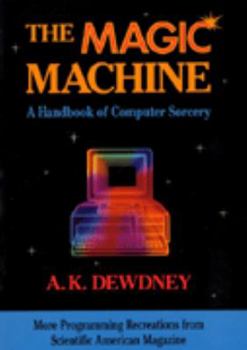The Magic Machine: A Handbook of Computer Sorcery
Select Format
Select Condition 
Book Overview
The computer recreations described here range from purely entertaining brain-teasers to more practical applications of scientific thought. Readers can mystically transform Dewdney's clear programming... This description may be from another edition of this product.
Format:Paperback
Language:English
ISBN:0716721449
ISBN13:9780716721444
Release Date:January 1990
Publisher:W.H. Freeman & Company
Length:357 Pages
Weight:1.50 lbs.
Dimensions:1.1" x 6.6" x 9.2"
Customer Reviews
2 ratings
Back when visual effects meant understanding algorithms
Published by Thriftbooks.com User , 16 years ago
Published back in 1990, these were the days when programmers of visual effects had to understand the mathematics and algorithms behind what they were doing - or at least copy them and type them in - because you couldn't buy the latest software that would do it for you. These were the fun days of programming such effects. The chapters are taken from the author's column in Scientific American, and have a variety of algorithms and their explanations and implementations. The following is the table of contents: 1. Mandelbrot Magic 2. Visions of Julia - on generating the Julia set 3. The Strange Attractions of Chaos - Contains a program on the simplest known chaotic system and also a program on the Henon attractor. 4. Catching Biomorphs - One program that generates algebraic lifeforms and another that produces fractal forms laid out on a grid. 5. Fractal mountains and graftal plants - A program that draws a profile of a mountain and another program that produces an L-system for generating a plant. 6. Hodgepodge reactions - Contains a program that creates a cellular automaton that produces a self-sustaining reaction. 7. The Demons of Cyclic Space - Contains a program that create a cellular automaton that evolves. 8. Slow Growths - Simulates natural clustering processes. 9. Programmed parties - A program shows how to produce people who party on a computer screen. 10. Palmiter's Protozoa - Simulates protozoa hunting bacteria. 11. Panning for Primes - Shows how to write various types of prime number generators. 12. Special FX - Worms crawl on a computer screen, raindrops fall on a pond surface, and we get a view from a spaceship. 13. Balls in a box - Balls bounce, diffuse, and create nucear chain reactions. 14. The Invisible Professor - Learn to draw a circle, a Tschirnhausen's cubic curve, a Hippopede curve, and finally the Bowditch curves. 15. Computers in the Crypt - Learn about the Date Encryption Standard (DES) code. 16. Core Wars - all about the Core War operating system. Maybe not useful in and of themselves, but they get you thinking about larger programs that use their principles. Highly recommended.
A greater book couldn't be written...
Published by Thriftbooks.com User , 26 years ago
This book talks about various aspects of fractals, biomorphs and many other very, very interesting aspects of maths. A book for beginners, intermediate and advanced readers. Algorithms and much more for computer programming. A MUST HAVE for everybody interested on fractals and computer science.





